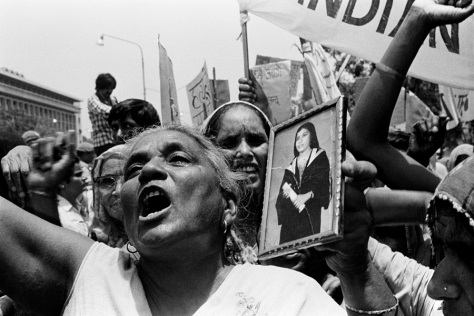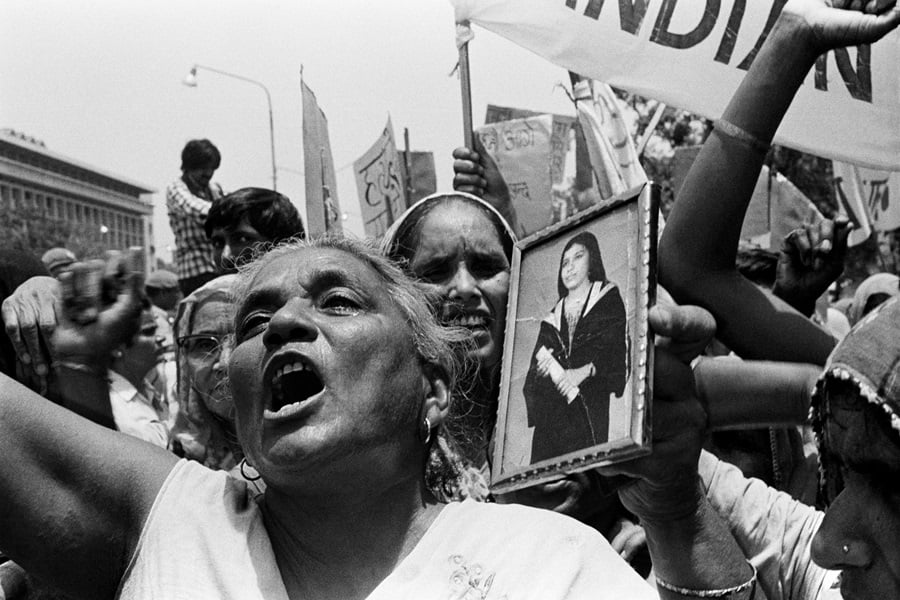Editor’s Note: FII’s #MoodOfTheMonth for March, 2022 is Women’s History Month. We invite submissions on the contributions of women, the trajectory of the feminist movement and the need to look at history with a gender lens, throughout the month. If you’d like to contribute, kindly email your articles to sukanya@feminisminindia.com
Satya Rani Chaddha was a women’s rights activist known for launching the anti dowry movement in India. She embarked on this difficult journey of social and legal reformation in the 1980s together with fellow activist Shahjahan Apa. Both of them lost their daughters to dowry disputes, together, they spent decades campaigning for justice and to change the dowry practices in India.
Enraged with dowry death of her then six months pregnant daughter Shashi Bala (also referred to as Kanchan) at the age of twenty, Satya Rani crossed her heart to not let a similar incident happen with someone else. She claimed that before marriage, the groom’s family demanded a scooter, a fridge and a television which they were unable to afford.
The court also informed that even when Shashi was pregnant, her husband continued to pressurise her and her family for additional dowry and warned of dire consequences if the demands were not met.
During the court sessions, it was brought to the notice that the deceased used to send letters to her mother Satya. “The victim in this span of 10 months of her married life, belonging to the middle class economic strata, was not wanting even her mother to know her pain; the letters written by her to her mother and to Mandirwali Mataji were almost like reassurances to herself, trying to persuade herself to believe that everything would be fine in her marital life; she must learn to trust her husband; at the same time informing her mother that her husband had sisters and should not harass anyone; this was an indirect mode of informing her mother that she herself was being harassed by her husband“, the court noted.
In an interview in a documentary named ‘The unlimited girls’, Satya Rani says, “My daughter was killed for dowry, others should not be killed, but they are; they are dying.”
Shakti Shalini was established in 1987, for the survivors of domestic and sexual violence. Both of them have fought numerous legal and cultural battles to serve justice to the survivors of violence. Ironically, Satya Rani did not get justice for her own daughter. In 1980 she filed charges of murder and abetment on Subhash Chandra and his family in the lower court. However within two months, he was out on bail. When the case was ratified in 2013, Subhash went absconding

Satya Rani’s fight against dowry
Bride burning is an act of domestic violence and a category of dowry death, where the bride is tortured, harrased and murdered by the husband or his family members due to the inability of the bride’s family to pay dowry.
One of the major reasons for the prevalence of dowry deaths is the continuance of considering women and girls as ‘burden’, especially a ‘financial burden’. In order to countervail this predicament, dowry in the form of cash, kind or ‘gift’ is given to the bridegroom’s family for taking on ‘ownership‘ of the bride. However, usually the husband and his family demand more goods after the marriage by pressurising and abusing the wife and her family; and those who fail to meet their ‘demands’ are subjected to violence and death.
Through the 1980s, when dowry deaths were on the rise, Satya Rani Chaddha attended rallies and campaigned to bring an end to this ‘custom’. To give the taste of justice to all the survivors of gender and sexual domestic violence, Satya Rani and Shahjahan Apa established an NGO named ‘Shakti Shalini’, which has also helped in the strengthening of anti-dowry laws.
Also read: The Historical Journey Of Anti-Dowry Laws

Shakti Shalini was established in 1987, for the survivors of domestic and sexual violence. Both of them have fought numerous legal and cultural battles to serve justice to the survivors of violence. Ironically, Satya Rani did not get justice for her own daughter.
In 1980 she filed charges of murder and abetment on Subhash Chandra and his family in the lower court. However within two months, he was out on bail. When the case was ratified in 2013, Subhash went absconding.
The legacy of Satya Rani
Turning her grief and trauma into determination to fight for timely justice for other survivors, Satya led a life of inimitable grit. Earlier, under the law, dowry was defined as ‘consideration for marriage’. The first amendment Act of 1983 changed the definition of dowry to include demand of ‘gift’ at any time during marriage.
Satya Rani Chadha passed away on 1st July 2014 and will always be remembered as the symbol of grit and resilience for the people she spent more than half of her life fighting
The criminal law amendment was brought into force which was inserted in the Indian Penal Code to deal with the cases related to cruelty. The second amendment act to section 113 A of the Indian Evidence Act says that abetment to suicide is presumed if a married woman dies by suicide within seven years of marriage and if her husband/in-laws have previously subjected her to any form of violence and cruelty.
However, as it is commonly said, ‘justice delayed is justice denied’, the political system lacks effective and systematic implementation of reforms and laws, which defeats the whole purpose behind the amendments that were made.
Sanjay Ghose, who was a lawyer for Chaddha’s case said, “If you have corrupt police and a tardy criminal justice system that takes so long to deliver justice, then obviously the laws are worthless; there is a parallel with the bus gang rape. You have this rush to amend the laws, but when the media heat has died, the activists have gone back to their house and the candlelight vigils are over, the public forgets.And dowry murder is no relic of the past.You could start a case tomorrow that could take that long.”
Satya Rani Chadha passed away on 1st July 2014 and will always be remembered as the symbol of grit and resilience for the people she spent more than half of her life fighting.
Also read: Lessons On Gender Equality From The Dowry-Free Adivasi Communities Of India
Featured Image: Sheba Chhachhi/Kafila
About the author(s)
Ishita is a student of Political Science (Honors) at Kamla Nehru college, Delhi University. In the world of patriarchy, she is not someone who is afraid to voice out her beliefs and speak up for them. Though mostly cheerful and friendly she is very particular about her deadlines and perfection in her chores





